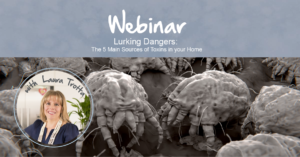Dust… it’s not a sexy topic but it is an important topic when it comes to maintaining a clean and healthy home.
With dust being a leading cause of environmental allergies in both children and adults, it pays to understand what dust is, how it accumulates in your home and how to get rid of it, for good!
In this post I’ll share what household dust is (and what it’s made up of), the health impacts of dust, how you can remove dust from your home and how you can help prevent it building up in the first place.
Podcast: Play in new window
Subscribe in iTunes
Living in Outback Australia, where dust storms are a way of life, it’s fair to say that dust and I are well acquainted. Sadly, it seems that I’m not alone and many of us are a little too well acquainted with dust. In fact 10% of the population are reportedly allergic to dust mites!
With dust being a leading cause of environmental allergies in both children and adults, it pays to understand what dust is, how it accumulates in your home and how to get rid of it, for good!
What Is Household Dust?
When we think of dust, the small particles of soil or sand blowing around outside generally come to mind, but household dust is a bit more complex.
Household dust is typically comprised of dried food particles, mould spores, pollen, fabric fibres, animal dander (i.e. tiny flecks of skin and fur from pets) and insect parts, especially those of dust mites and cockroaches (eeww!)
While many of these components can cause health implications, it’s generally the particles and debris from dust mites that are the major source of allergens in household dust.
What Are The Health Implications Of Household Dust?
House dust mites flew under the radar until the mid-1960’s when they were discovered. They’re microscopic arachnids, about one third of a millimetre in length, are invisible to the naked eye, have eight legs, are blind, and naturally live indoors.
House dust mites feed on human secretions and the skin cells we shed. It’s therefore not surprising that the bedroom is their favourite habitat. They particularly thrive in items such as mattresses, pillows, stuffed toys, blankets, curtains, carpets and upholstered furniture.
Digestive enzymes present in the dust mite’s faeces are the most troublesome of the house dust mite allergens. These tiny faecal pellets break down into a very fine powder that easily becomes airborne when disturbed through activities such as vacuuming, making the bed, rolling over when in bed and even just treading on carpet.
When an allergic person inhales these particles, asthma or other allergy symptoms may occur. Unlike pollen allergies which tend to occur seasonally, dust mite allergies generally occur all year round. Typical symptoms include itchy and watery eyes, sneezing, a runny or blocked nose, dry persistent cough, wheezing and dermatitis. Symptoms can often be worse at night or upon waking and generally improve throughout the day when away from the source.
It is believed that around 10% of the population is allergic to dust mites and about 80% of asthmatic children are allergic to dust mites.
How To Remove Household Dust
Like many home cleaning tasks, keeping on top of dust requires ongoing effort. It can come as a surprise to many that general vacuuming and dusting activities often don’t eliminate dust mites, they just make the dust particles airborne.
To really make an impact you need a quality vacuum cleaner that’s fitted with an HEPA (high efficiency particulate air) filter and a motorised head (note: you only need the motorised head if you have carpets or rugs as its purpose is to get into the pile). The HEPA filter is critical because it filters down to 0.3 µm, preventing the smaller dust particles from becoming airborne and exposing your family to allergens.
Installing the HEPA filter onto your vacuum is only half the solution; the other is allowing the vacuum enough time to do its job.
This means taking your time when vacuuming your house; a quick once over just won’t cut it. Instead, take a minute or two per spare metre to really get into the pile to allow the vacuum to collect as much dust as possible.
Once you’ve thoroughly vacuumed your carpets, use a dry microfibre cloth to remove dust from furniture and appliances. Holding the smallest particles in its fibres, microfibre cloths create an electrostatic charge that attracts even the smallest particles of dirt (you can read more about microfibre cloths and how they work here).
Finish with a damp microfibre cloth to remove grime and any residual dust. Simply wet, wring well, fold flat and wipe away grime from the surface. My favourite dusting cloths are the Norwex Dusting Mitt and Enviro Cloths (available here), however the ENJO Dust Glove and Indoor Miracle also perform well (available here).
Other Ways To Keep Dust Levels Down In Your Home
In addition to investing in a quality vacuum cleaner to remove household dust from your carpets and furniture, and microfibre cloths to clean dust from solid areas, you can also work at reducing dust levels, and the risk of dust allergies, inside your home by:
- Removing shoes before entering the home and installing door mats at every entrance.
- Keeping your pets outside or containing them to one room (and bed) inside your home as well as brushing their hair regularly to reduce the amount of dander they drop inside the home.
- Choosing tiles or floorboards over carpets in your home, especially in bedrooms.
- Opting for leather, metal or wooden furniture over fabric furnishings such as couches and upholstery.
- Reducing clutter in your home, particularly in and around beds.
- Avoiding sleeping with soft toys and sheepskin products. To remove household dust mites from soft toys, freeze inside two freezer bags overnight (at least 16 hours), thaw, wash in hot water and line dry. Repeat every two months. The freezing is required to kill the dust mites and the washing removes the allergens
Reducing allergens associated with dust mites is just one of the many areas to tackle when creating a safe, healthy home that’s free of nasty toxins.
When it comes to toxin-free living there’s many sources in our homes that fly “under the radar”.
If you’re keen to discover the 5 Main Sources of Toxins In Your Home, reserve your seat on my free LIVE Online Event here.
For guidance and support to help you create a cleaner, greener and healthier home, check out my Home Detox Boot Camp. Doors will be closing soon on the final round of 2016!
Podcast: Play in new window | Download
- Sustainable Home Design- factors to consider to maximise sustainability - July 28, 2022
- Advantage and Disadvantages of Tiny Houses - May 31, 2022
- How School Strike 4 Climate is Empowering Youth to Fight for Their Future - May 1, 2022




 Laura Trotta is one of Australia’s leading home sustainability experts. She has a Bachelor of Environmental Engineering, a Masters of Science (in Environmental Chemistry) and spent 11 years working as an environmental professional before creating her first online eco business, Sustainababy, in 2009. She has won numerous regional and national awards for her fresh and inspiring take on living an ‘ecoceptional’ life (including most recently winning the Brand South Australia Flinders University Education Award (2015) for the north-west region in SA and silver in the Eco-friendly category of the 2015 Ausmumpreneur Awards). With a regular segment on ABC Radio and with her work featured in publications like Nurture Parenting and My Child Magazine, Laura is an eco thought leader who’s not afraid to challenge the status quo. A passionate believer in addressing the small things to achieve big change, and protecting the planet in practical ways, Laura lives with her husband and two sons in outback South Australia.
Laura Trotta is one of Australia’s leading home sustainability experts. She has a Bachelor of Environmental Engineering, a Masters of Science (in Environmental Chemistry) and spent 11 years working as an environmental professional before creating her first online eco business, Sustainababy, in 2009. She has won numerous regional and national awards for her fresh and inspiring take on living an ‘ecoceptional’ life (including most recently winning the Brand South Australia Flinders University Education Award (2015) for the north-west region in SA and silver in the Eco-friendly category of the 2015 Ausmumpreneur Awards). With a regular segment on ABC Radio and with her work featured in publications like Nurture Parenting and My Child Magazine, Laura is an eco thought leader who’s not afraid to challenge the status quo. A passionate believer in addressing the small things to achieve big change, and protecting the planet in practical ways, Laura lives with her husband and two sons in outback South Australia. 


